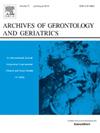社会隔离对居住在社区的日本老年人脑容量变化的影响:NEIGE 研究
IF 3.5
3区 医学
Q2 GERIATRICS & GERONTOLOGY
引用次数: 0
摘要
背景多项研究表明,社会隔离是认知能力下降和痴呆症的一个风险因素;然而,人们对其神经机制还不完全了解。本研究利用纵向数据,研究了社会隔离对社区居住的日本老年人海马体和总灰质体积的影响。方法数据来自在十日町市(日本新泻县)进行的神经元对环境的跨代影响(NEIGE)研究,包括 279 名 65-84 岁的社区居住者,他们在 2017 年和 2021 年接受了脑磁共振成像检查(男性:47.6%;平均年龄:73.0 岁)。我们调查了社会隔离的两个维度:社会网络不健全和独居。结果使用反概率加权的多元回归分析表明,社会接触频率为<1次/周的人比接触频率大于或等于4次/周的人的海马体积下降幅度更大,而独居者的海马体积下降幅度往往小于与他人共同生活的人。我们发现,社会接触频率、独居和灰质总体积之间没有关联。结论我们的纵向分析表明,社会隔离与痴呆症发病之间的关系可能是由海马体萎缩介导的;但是,影响的方向取决于隔离的类型。这些发现有望为阐明痴呆症发病的社会机制做出贡献。本文章由计算机程序翻译,如有差异,请以英文原文为准。
Impact of social isolation on change in brain volume in community-dwelling older Japanese people: The NEIGE Study
Background
Several studies have shown that social isolation is a risk factor for cognitive decline and dementia; however, its neurological mechanisms are not fully understood. Using longitudinal data, this study examined the effects of social isolation on hippocampal and total gray matter volumes in community-dwelling older Japanese individuals.
Methods
Data were obtained from the Neuron to Environmental Impact Across Generations (NEIGE) Study conducted in Tokamachi City (Niigata Prefecture, Japan), including 279 community-dwelling persons aged 65–84 years who underwent brain magnetic resonance imaging in 2017 and 2021 (male: 47.6 %; mean age: 73.0 years). We investigated two dimensions of social isolation: poor social networks and solitary living.
Results
Multiple regression analysis with inverse probability weighting showed that individuals with a social contact frequency of <1 time/week had a greater decrease in hippocampal volume than those with a contact frequency of more than or equal to 4 times/week, whereas those who lived alone tended to have a smaller decrease in hippocampal volume than those who lived with others. We found no association between the frequency of social contact, living alone, and total gray matter volume. Furthermore, there was no interaction between sex and age for any of the outcomes.
Conclusion
Our longitudinal analysis suggested that the relationship between social isolation and dementia onset may be mediated by hippocampal atrophy; however, the direction of the influence depends on the isolation type. These findings are expected to contribute to the elucidation of the social mechanisms underlying dementia onset.
求助全文
通过发布文献求助,成功后即可免费获取论文全文。
去求助
来源期刊
CiteScore
7.30
自引率
5.00%
发文量
198
审稿时长
16 days
期刊介绍:
Archives of Gerontology and Geriatrics provides a medium for the publication of papers from the fields of experimental gerontology and clinical and social geriatrics. The principal aim of the journal is to facilitate the exchange of information between specialists in these three fields of gerontological research. Experimental papers dealing with the basic mechanisms of aging at molecular, cellular, tissue or organ levels will be published.
Clinical papers will be accepted if they provide sufficiently new information or are of fundamental importance for the knowledge of human aging. Purely descriptive clinical papers will be accepted only if the results permit further interpretation. Papers dealing with anti-aging pharmacological preparations in humans are welcome. Papers on the social aspects of geriatrics will be accepted if they are of general interest regarding the epidemiology of aging and the efficiency and working methods of the social organizations for the health care of the elderly.

 求助内容:
求助内容: 应助结果提醒方式:
应助结果提醒方式:


